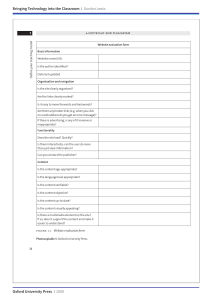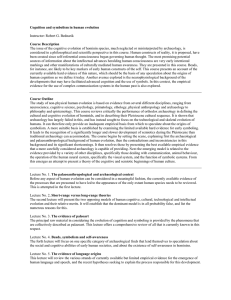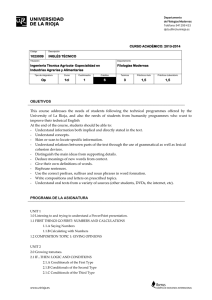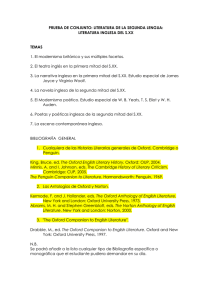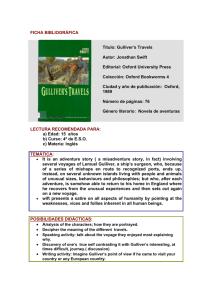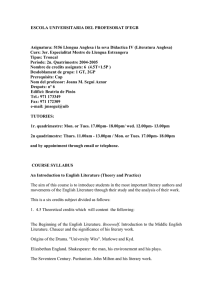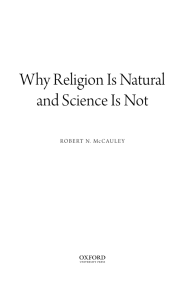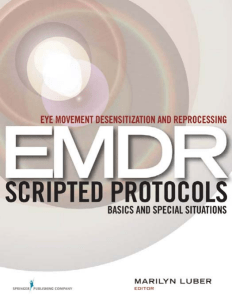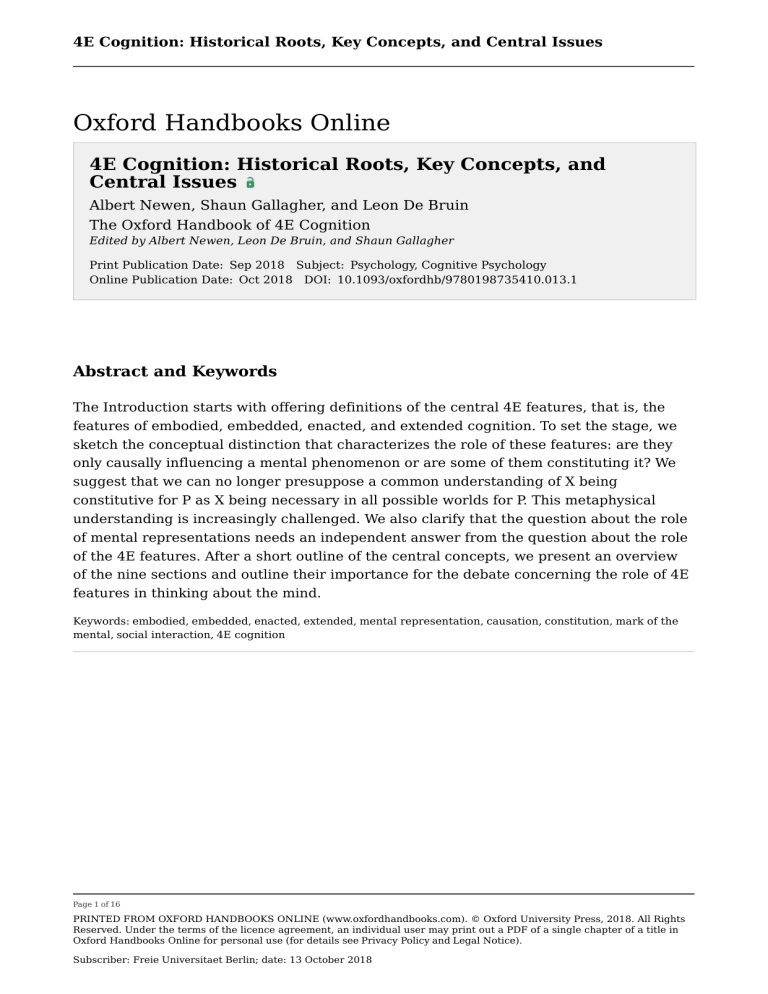
4E Cognition: Historical Roots, Key Concepts, and Central Issues Oxford Handbooks Online 4E Cognition: Historical Roots, Key Concepts, and Central Issues Albert Newen, Shaun Gallagher, and Leon De Bruin The Oxford Handbook of 4E Cognition Edited by Albert Newen, Leon De Bruin, and Shaun Gallagher Print Publication Date: Sep 2018 Subject: Psychology, Cognitive Psychology Online Publication Date: Oct 2018 DOI: 10.1093/oxfordhb/9780198735410.013.1 Abstract and Keywords The Introduction starts with offering definitions of the central 4E features, that is, the features of embodied, embedded, enacted, and extended cognition. To set the stage, we sketch the conceptual distinction that characterizes the role of these features: are they only causally influencing a mental phenomenon or are some of them constituting it? We suggest that we can no longer presuppose a common understanding of X being constitutive for P as X being necessary in all possible worlds for P. This metaphysical understanding is increasingly challenged. We also clarify that the question about the role of mental representations needs an independent answer from the question about the role of the 4E features. After a short outline of the central concepts, we present an overview of the nine sections and outline their importance for the debate concerning the role of 4E features in thinking about the mind. Keywords: embodied, embedded, enacted, extended, mental representation, causation, constitution, mark of the mental, social interaction, 4E cognition Page 1 of 16 PRINTED FROM OXFORD HANDBOOKS ONLINE (www.oxfordhandbooks.com). © Oxford University Press, 2018. All Rights Reserved. Under the terms of the licence agreement, an individual user may print out a PDF of a single chapter of a title in Oxford Handbooks Online for personal use (for details see Privacy Policy and Legal Notice). Subscriber: Freie Universitaet Berlin; date: 13 October 2018 4E Cognition: Historical Roots, Key Concepts, and Central Issues Historical Roots of the Debate The debate about the role of the body in cognition has been ongoing since close to the beginnings of philosophy. In Plato’s dialogue The Phaedo, for example, Socrates considers the idea, which he attributes to Anaxagoras, that one could explain his decision to remain in prison by a purely material or physical explanation in terms of bodily mechanisms. Socrates himself rejects this idea—surely, he thinks, there is something more to reason than just bodily processes. Aristotle, however, was motivated by the idea that Anaxagoras was not entirely wrong. While Aristotle did not accept the radical view of Anaxagoras, he considered that the body (with special reference to the hands) may play some role in what makes for human rationality. Such debates considering the role of the body for the mind can be traced through medieval texts authored by Neoplatonists, Aquinas, and others, and are given their modern formulations in thinkers such as Spinoza, La Mettrie, Condillac, and many others. Pragmatists, phenomenologists, and philosophers of mind wrestle with the same issues throughout the twentieth century. The more proximate background for the current debates about embodied cognition, however, is to be found in the disagreements between behaviorists and cognitivists. Continuing tensions within cognitivism, and the cognitive sciences more generally, brought on by contrasting functionalist and neurobiological accounts that tended to ignore the role of body and environment and focus on internalist explanations of brain function, set the stage for the emergence of contemporary views on embodied cognition. In the 1990s, Varela, Thompson, and Rosch’s (1991) The Embodied Mind, drawing on phenomenological and neurobiological resources, proposed an enactivist account of cognition that emphasized the role of the dynamical coupling of brain–body– environment. Around the same time, a paper by Flor und Hutchins (1991) introduced (p. 4) distributed cognition as a “new branch of cognitive science” for which the unit of analysis includes external structures, collectives, and artifacts organized as a system to perform a task. Hutchins’s (1995) Cognition in the Wild was a direct influence on Clark and Chalmers’s (1998) now-classic philosophical essay, “The Extended Mind.” Throughout this time period, additional work inspired by Gibson’s ecological approach to psychology contributed to a growing realization that cognition was not limited to processes in the head, but was embodied, embedded, extended, and enactive. Although the concept of 4E cognition1 brings these different approaches together under one heading and conceives of them as coherently opposed to the internalist, braincentered views of cognitivism, there are continuing disagreements about a variety of issues within and among these embodied approaches. Is cognition embodied, embedded, extended, or enactive? The issues that continue to be debated concern the very nature of embodiment, the precise way that brain, body, and environment are coupled or integrated in cognition, and how much we can generalize from the observation of embodiment in one type of cognitive performance to others. Furthermore, there are questions about the role Page 2 of 16 PRINTED FROM OXFORD HANDBOOKS ONLINE (www.oxfordhandbooks.com). © Oxford University Press, 2018. All Rights Reserved. Under the terms of the licence agreement, an individual user may print out a PDF of a single chapter of a title in Oxford Handbooks Online for personal use (for details see Privacy Policy and Legal Notice). Subscriber: Freie Universitaet Berlin; date: 13 October 2018 4E Cognition: Historical Roots, Key Concepts, and Central Issues of representations and what it means to say that cognition is “constituted” by bodily and environmental processes. Key Concepts How to Individuate Cognitive Processes Before introducing the key concepts in the debate, we first need to consider whether there are certain constraints that need to be taken into account in order to answer the question of what cognition is and how we should individuate cognitive processes. If we take cognition as a natural kind (even if we do not know the underlying mechanisms) this would limit the nature of our investigation to a search for the relevant mechanism constituting it. But there is no consensus on this question: while Buckner (2015) argues that cognitive processes are indeed natural kinds, evidence about neural plasticity presents a strong challenge to this claim (Hübener and Bonhoeffer 2014). An alternative strategy for answering the question is to focus on typical examples (Newen 2015). This seems to be a promising strategy, but it is not without problems. One complication is that a selection of the typical examples is already biased by certain assumptions (p. 5) concerning the nature of cognition. Thus, where traditional cognitive science focused primarily on playing chess and mastering the “Tower of Hanoi,” i.e., tasks that are strongly rule-governed, proponents of 4E cognition appeal to experiments that involve spatial navigation, face-based recognition of emotion, and basic forms of social interaction. It is therefore paramount to get a clear view on the assumptions about cognition that are made by proponents of both positions. 4E Cognition and Traditional Cognitive Science The foundation of traditional cognitive science used to be the representational and computational model of cognition (RCC). According to this model, cognition is a kind of information processing that consists in the syntactically driven manipulation of representational mental structures. In particular, cognitive processes were said to be (1) abstract, a-modal processes that mediate between modality-specific sensory inputs (perception) and motor outputs (action), and (2) computations over mental representations that are either symbolic (e.g., concepts in a “language of thought”; Fodor 1975) or sub-symbolic (e.g., activations in neural networks; Rumelhart et al. 1986). The RCC also involves a specific view of where cognition was supposed to take place—some kind of “contingent intracranialism” (Adams and Aizawa 2008). On this view, cognitive processes are, as far as their ontology is concerned, realized by brain processes only (at Page 3 of 16 PRINTED FROM OXFORD HANDBOOKS ONLINE (www.oxfordhandbooks.com). © Oxford University Press, 2018. All Rights Reserved. Under the terms of the licence agreement, an individual user may print out a PDF of a single chapter of a title in Oxford Handbooks Online for personal use (for details see Privacy Policy and Legal Notice). Subscriber: Freie Universitaet Berlin; date: 13 October 2018 4E Cognition: Historical Roots, Key Concepts, and Central Issues least in the case of humans and other animals), and as far as their explanation is concerned, understandable and explainable by focusing on brain processes only. During the past couple of decades, these key elements of the RCC—the pivotal role of computation and representation in all cognitive processing and the pivotal role of a central processing unit in the brain as the sole relevant factor of cognitive processing— have come under pressure (Gallagher 2005; Walter 2014). Proponents of 4E cognition have argued against the assumption that cognition is an isolated and abstract, quasiCartesian affair in a central processing unit in a brain. This idea is typically associated with functionalism, which claims that cognitive phenomena are fully determined by their functional role and therefore form an autonomous level of analysis. According to proponents of 4E cognition, however, the cognitive phenomena that are studied by modern cognitive science, such as spatial navigation, action, perception, and understanding other’s emotions, are in some sense all dependent on the morphological, biological, and physiological details of an agent’s body, an appropriately structured natural, technological, or social environment, and the agent’s active and embodied interaction with this environment. Even most of the phenomena studied by traditional cognitive science—such as language processing (e.g., Glenberg and Kaschak 2002), memory (Casasanto and Dijkstra 2010), visual-motor recalibration (Bhalla and Proffitt 1999) and perception-based distance estimation (Witt and Proffitt 2008)—are not abstract, modality-unspecific processes in a central processing area either, but essentially rely on the system’s body and its dynamical and reciprocal real-time interaction with its environment. Thus, by maintaining that cognition involves extracranial bodily processes, 4E approaches depart markedly from the RCC view that the brain is the sole basis of cognitive processes. But what precisely does it mean to say that cognition involves extracranial processes? First of all, the involvement of extracranial processes can be understood in a strong and a weak way. According to the strong reading, cognitive processes are partially constituted by extracranial processes, i.e., they are essentially based on them. By contrast, according to the weak reading, they are non-constitutionally related, i.e., only causally dependent upon extracranial processes. Furthermore, cognitive processes can count as extracranial in two ways. Extracranial processes can be bodily (involving a brain–body unit) or they can be extrabodily (involving a brain–body– environment unit). (p. 6) Following this line of reasoning, we can distinguish between four different claims about embodied cognition: a. A cognitive process is strongly embodied by bodily processes if it is partially constituted by (essentially based on) processes in the body that are not in the brain; b. A cognitive process is strongly embodied by extrabodily processes if it is partially constituted by extrabodily processes; Page 4 of 16 PRINTED FROM OXFORD HANDBOOKS ONLINE (www.oxfordhandbooks.com). © Oxford University Press, 2018. All Rights Reserved. Under the terms of the licence agreement, an individual user may print out a PDF of a single chapter of a title in Oxford Handbooks Online for personal use (for details see Privacy Policy and Legal Notice). Subscriber: Freie Universitaet Berlin; date: 13 October 2018 4E Cognition: Historical Roots, Key Concepts, and Central Issues c. A cognitive process is weakly embodied by bodily processes if it is not partially constituted by but only partially dependent upon extracranial processes (bodily processes outside of the brain); d. A cognitive process is weakly embodied by extrabodily processes if it is not partially constituted by but only partially dependent upon extrabodily processes. The last version of the claim (d) is identical with the property of being embedded, i.e., being causally dependent on extrabodily processes in the environment of the bodily system. Furthermore, being extended is a property of a cognitive process if it is at least partially constituted by extrabodily processes (b), i.e., if it extends into essentially involved extrabodily components or tools (Stephan et al. 2014; Walter 2014). Many proponents of 4E cognition not only maintain that cognition involves extracranial processes, but also that cognition is enacted in the sense that it involves an active engagement in and with an agent’s environment (Varela, Thompson, and Rosch 1991). We can distinguish between two versions of this claim: e. A cognitive process is strongly enacted if it is partially constituted by the ability or disposition to act; f. A cognitive process is weakly enacted if it is only partially dependent upon the ability or disposition to act. It should be emphasized that proponents of 4E cognition differ greatly in terms of their commitments to these claims, and consequently in their interpretation of what it means for cognition to be embodied, embedded, extended, and enactive. One famous example of an enacted theory of cognition is Noë’s (2004) theory of perception, according to which perception is not something passive that happens to us or in us but something we (p. 7) do: according to him, having a 3D-perceptual experience of an object includes having a specific disposition to act which he spells it out in terms of implicit knowledge of sensorimotor contingencies. It is part of the discussion whether this justifies a strong or only a weak enactment claim (Engel et al. 2013). Page 5 of 16 PRINTED FROM OXFORD HANDBOOKS ONLINE (www.oxfordhandbooks.com). © Oxford University Press, 2018. All Rights Reserved. Under the terms of the licence agreement, an individual user may print out a PDF of a single chapter of a title in Oxford Handbooks Online for personal use (for details see Privacy Policy and Legal Notice). Subscriber: Freie Universitaet Berlin; date: 13 October 2018 4E Cognition: Historical Roots, Key Concepts, and Central Issues Constitution Versus Causal Dependency As we saw earlier, the distinction between constitution and causal dependency plays an important role in the debate on embodied cognition. But what exactly grounds this distinction? Consider the example of cognitive processes involved in solving a simple math problem. It likely involves visual perception (if the problem is presented on paper), memory, language or symbol processing, etc. This means it would depend on a variety of elements and processes that include neuronal processes in the visual cortex, in motor areas, in language areas, the hippocampus, frontal areas, etc. In addition, as I read the problem I move my eyes, and likely my head. I posture my body so that my eyes are a certain distance from the text. I may gesture with my hands as I work out the solution. All of these factors can be involved even if I am solving the problem “in my head,” without pencil and paper or other instruments. If I am involved in a competition to solve the problem, that stressful fact may have an effect on my cognitive performance. Can proponents of embodied cognition claim that not only the neuronal processes, but also eye movements, head movements, posture, use of pencil and paper, and perhaps even the competitive situation are all parts of the cognitive system that constitutes cognition in this case? When they make such claims, critics have accused them of the so-called coupling/constitution fallacy (Adams and Aizawa 2008; Rupert 2009), according to which the strong coupling between neural and extraneural processes, including bodily movement and use of pencil and paper, for example, does not suffice to make the nonneural processes constituents, rather than just causal or enabling conditions of the cognitive process. Quite generally, the question is whether, and if so, how, we are able to decide (either empirically, pragmatically, or a priori) whether a particular cognitive process is constituted by or merely dependent upon extracranial or extrabodily processes. One strategy in this debate is to question whether the concept of constitution necessarily involves just non-causal, part-whole relations (e.g., Craver 2007), or in some cases requires diachronic and dynamical relations that depend on reciprocal causality (e.g., Kirchhoff 2014, 2015; Leuridan 2012). Another strategy is to take relevant features as constitutive of a cognitive process (e.g., an emotion or an episode of self-consciousness) if it is a characteristic feature of the phenomenon and part of a minimal pattern of integrated features sufficient to realize this phenomenon (e.g., Newen et al. 2015; Gallagher 2013). It may be that most of the features of mental phenomena are neither necessary nor sufficient but only characteristic. For example, a facial expression of fear is partially constitutive of fear although there are realizations of fear that do not involve the typical facial expression, e.g., in the case of a trained poker face (Newen et al. 2015). Issues about (p. 8) the relation of constitutive, causal, or background conditions are unresolved, and are still subject to ongoing debate in the embodied cognition literature. Mental Representations Page 6 of 16 PRINTED FROM OXFORD HANDBOOKS ONLINE (www.oxfordhandbooks.com). © Oxford University Press, 2018. All Rights Reserved. Under the terms of the licence agreement, an individual user may print out a PDF of a single chapter of a title in Oxford Handbooks Online for personal use (for details see Privacy Policy and Legal Notice). Subscriber: Freie Universitaet Berlin; date: 13 October 2018 4E Cognition: Historical Roots, Key Concepts, and Central Issues Another important question in the debate on embodied cognition concerns what role, if any, mental representations play in cognitive processing. The theoretical landscape is such that 4E approaches can and in fact do have supporters from both the computational/ representational and the anti-computational/anti-representational camp. Dynamicists like Chemero (2009), for instance, defend a decidedly anti-computational/antirepresentational version of embodied cognition (see also Barrett 2011), while Wilson’s (1994) “wide computationalism” and Clark’s (2008) “extended functionalism,” according to which the mind is the joint product of intracranial processing, bodily input, and environmental scaffolding, are unequivocally computational/representational. In a similar vein, while some proponents of embodied cognition, for instance, in the area of vision research, explicitly try to supersede traditional computational/representational approaches (Gibson 1979; Noë 2004; Hutto and Myin 2013), others merely try to enrich them by integrating environmental resources (Ballard et al. 1997; Clark 2013). Thus, embodied approaches range from the computation/representation friendly variety (Alsmith and de Vignemont 2012; Prinz 2009) to accounts that are explicitly anticomputational and/or anti-representational (see Thelen et al. 2001; Brooks 1991; Pfeifer and Bongard 2006). This shows that the 4E approach as such does not presuppose a specific view on representation and computation. An Overview of This Book Since the volume is organized in nine additional parts, we will provide a short overview of the main questions that are treated in these parts. Part 2: What is Cognition? The second part of essays explores the concept of cognition specifically from the perspectives offered by 4E approaches to the mind. From a standard viewpoint, the debates around embodied approaches seem to turn the “what” question into the “where” question, so that the answer to the question about the nature of cognition is first of all about location: precisely where is cognition located? In this regard the line that demarcates between inside and outside plays an important role. From the perspective of (p. 9) the 4Es, however, the question of location is less critical; indeed, the distinction between inside and outside is downplayed, and the boundary line turns out to be a movable and permeable border. Thus, on the extended mind paradigm, if you happen to be using a piece of the environment to assist memory or to solve a problem, then in that case the mind extends into the environment; on the enactivist view, if there is a dynamical coupling to others or to tools in joint action, then there is no line that cuts the organism off from these other social and environmental factors. Cognition is affordance-based, where affordances are always relational (between the cognizing subject or some form of life and the possibilities offered by some entity or complex of entities), and where entity Page 7 of 16 PRINTED FROM OXFORD HANDBOOKS ONLINE (www.oxfordhandbooks.com). © Oxford University Press, 2018. All Rights Reserved. Under the terms of the licence agreement, an individual user may print out a PDF of a single chapter of a title in Oxford Handbooks Online for personal use (for details see Privacy Policy and Legal Notice). Subscriber: Freie Universitaet Berlin; date: 13 October 2018 4E Cognition: Historical Roots, Key Concepts, and Central Issues may be some physical part of the environment, another person who can provide information or opportunity, a social or cultural structure, or even something more abstract, such as a concept that, with some manipulation, offers a solution to a problem. Such approaches transform the question about cognition into questions about the nature of affordances, about whether cognition is extended or extensive, about what precisely we mean by coupling, about whether a dynamical systems approach can do without representations, and so forth. Part 3: Modeling and Experimentation How should we go about answering such questions? This question is taken up in Part 2, as well as in other parts of this volume. There is general agreement that a priori definitions or models of cognition are not helpful, and that we need to conduct experiments and consult the empirical literature. 4E approaches are part of cognitive science and as such offer models that need to be tested using a variety of methods drawn from different disciplines. This part draws on research in experimental psychology and neuroscience, developmental psychology, dynamical systems theory, predictive processing, and so on. Testable models are required, not only for the most basic forms of human cognition found in infancy, or in perceptual crossing experiments, but in the more complex instances of social interactions and cultural expression. One question here is whether one model (e.g., predictive processing or dynamical systems theory) can explain the broad varieties of cognitive events by itself, or whether we need an integration of different models for different forms of cognition. This pushes further to the question of whether such integration is possible and whether there is some consistency between predictive processing, dynamical systems theory, and the various interpretations of these models found in cognitivism, extended mind, enactivist, and ecological approaches. Equally critical are questions about whether experimental science remains business as usual, or whether the more holistic demands of 4E approaches—to account for not just brain processes, and not just bodily and affective processes, and not just environmental and social and cultural processes, but all of these as they function together to shape cognition—put pressure on what we can operationalize and test. Page 8 of 16 PRINTED FROM OXFORD HANDBOOKS ONLINE (www.oxfordhandbooks.com). © Oxford University Press, 2018. All Rights Reserved. Under the terms of the licence agreement, an individual user may print out a PDF of a single chapter of a title in Oxford Handbooks Online for personal use (for details see Privacy Policy and Legal Notice). Subscriber: Freie Universitaet Berlin; date: 13 October 2018 4E Cognition: Historical Roots, Key Concepts, and Central Issues (p. 10) Part 4: Cognition, Action, and Perception Traditional analyses of perception tend to focus on sensory processing as it happens in cortical areas that correspond to different sense modalities, and questions concerning cognitive penetration. 4E approaches, in contrast, place significant emphasis on embodied action and the idea that perception is action-oriented. Furthermore, it often challenges the orthodox view, found in Helmholtz and recent models of predictive coding, that perception is inferential. Gibson worked out a theory of direct (non-inferential) perception that was controversial from the start, but that nonetheless continues to be developed in recent work in ecological psychology. Putting direct perception together with the focus on action complicates the picture, which is complicated further if we think that object perception is not equivalent to social perception, and that direct social perception is involved in joint actions. These are issues explored in this part, but they are basic ones that tie directly into questions about intentionality, spatial perception, social cognition, evolution, culture, brain plasticity, and the nature of cognition in nonhuman animals and robots—all of which are explored in later parts. Importantly, it remains controversial whether the principles worked out for perception and action, sometimes referred to as “basic” cognition, scale up to apply to higher-order operations and cognition in general. Part 5: Brain–Body–Environment Coupling and Basic Sensory Experiences This part explores concepts of intentionality found in 4E approaches. The notion that perception is action-oriented leads to a consideration of a very basic motor intentionality —a concept that derives from phenomenology (e.g., Merleau-Ponty 2012), but that can also be found in pragmatists such as John Dewey. As Robert Brandom notes, citing Dewey, the “most fundamental kind of intentionality (in the sense of directedness toward objects) is the practical involvement with objects exhibited by a sentient creature dealing skillfully with its world” (2008, p. 178). This captures a form of intentionality that is built into skillful bodily movement in tandem with environmental demands. Indeed, one might argue that it is just this kind of intentionality that should be considered “non-derived” intentionality, which is seemingly the favorite candidate for the “mark of the mental.” Alternatively, one might think that given the complexity of cognition, there is no one mark of the mental, but that one requires, perhaps, a pattern of factors to explain the varieties of cognitive practices. One issue at stake here is the very notion of embodiment as it defines embodied cognition. Whether embodiment is something that is reducible to neural representations, or requires some forms of complex coupling between brain, body, and environment, is one of the central issues that defines debates about cognition. (p. 11) Part 6: Social Cognition Page 9 of 16 PRINTED FROM OXFORD HANDBOOKS ONLINE (www.oxfordhandbooks.com). © Oxford University Press, 2018. All Rights Reserved. Under the terms of the licence agreement, an individual user may print out a PDF of a single chapter of a title in Oxford Handbooks Online for personal use (for details see Privacy Policy and Legal Notice). Subscriber: Freie Universitaet Berlin; date: 13 October 2018 4E Cognition: Historical Roots, Key Concepts, and Central Issues In many explanations of cognition, the concept of social cognition is regarded as a specialized topic. Although it is, in some regards, a specialized form of cognition that involves understanding other conspecifics, for some 4E approaches it also forms a more generalized constraint on cognition overall since most of what we consider human cognition originates in social interactions. Social cognition is itself a sophisticated form of cognition that spans a large spectrum of circumstances, from very basic embodied interactions that involve perception of and response to movement, posture, facial expression, gestures, and situated actions, to complex actions and joint actions within a large variety of everyday and specialized social and institutional frameworks. In this regard, social cognition may involve capacities for basic, empathic, embodied resonance processes, as well as more knowledge-based practices that involve conscious inference and familiarity with the person or group with whom one is engaged. If the various theories of embodied cognition have sometimes challenged the more standard theory-ofmind approaches to this topic, the overall suggestion of the papers in this part is that a pluralistic approach that includes a variety of capabilities and practices may be more appropriate in order to deal with the multiple forms of social cognition that need to be explained. Part 7: Situated Affectivity The concept of emotion, or more generally, affect, has come to play a larger role in mainstream analyses of cognition over the past 20 years. Cognition is not the narrow, hard, cold process of ratiocinative intellect that seems to fit so well with the computational model. Affect requires a more embodied and situated conception of cognition, and we need to recognize that it permeates cognitive processes, rather than occasionally penetrating them. One can trace the role of embodied affect from early infancy, through empathic processes, into sophisticated social situations that characterize adulthood. In this respect, it is not just emotion or the conscious feeling of emotion that is important; rather, non-conscious and wide-ranging affective processes that manifest in terms of hunger, fatigue, pain and pleasure, satiation and satisfaction can bias perception and thinking. My everyday intentionality, for example, is always conditioned by particular interests, and such interests are always modulated by a variety of affects, including emotions and moods. My anger makes me see things in specific ways; my joy leads me to ignore some of the negative factors in my environment; my fear moves me to act one way rather than another; my dark funk makes this rather than that matter. What I remember, what I perceive, how I respond to another person—all of these cognitive performances are pushed and pulled by affective factors, and these need to be accounted for in any account of cognition, whether it’s framed in terms of predictive processing, dynamical systems theory, social and environmental situations or empathic resonance. (p. 12) Part 8: Language and Learning Page 10 of 16 PRINTED FROM OXFORD HANDBOOKS ONLINE (www.oxfordhandbooks.com). © Oxford University Press, 2018. All Rights Reserved. Under the terms of the licence agreement, an individual user may print out a PDF of a single chapter of a title in Oxford Handbooks Online for personal use (for details see Privacy Policy and Legal Notice). Subscriber: Freie Universitaet Berlin; date: 13 October 2018 4E Cognition: Historical Roots, Key Concepts, and Central Issues On some accounts, language is deeply rooted in bodily movements, not only for its material performance, but also for its semantic sense, and even to the extent that language transcends the body toward high cultural accomplishments (as Merleau-Ponty 2012 suggests), it remains tied to it. At the same time that “speech accomplishes thought” (again to borrow a phrase from Merleau-Ponty), it remains a form of action, and most frequently a form of communicative action. Communication is not all linguistic, strictly speaking, since there are significant aspects of nonverbal communication involved from the very beginning; but linguistic communication is required for establishing most of human social practices and the normativity that comes with those practices. In that sense, language is a bridge from very basic embodied practices to the most sophisticated practices and rituals of instituted and normative life that come along with standards of correctness, the senses of rightness and wrongness, and the practice of giving reasons in our everyday social engagements. The bridge goes both ways since what results from linguistic practice loops back to shape our bodily actions and affective life. Part 9: Evolution and Culture 4E cognition, in contrast to anthropocentric views, which take cognition to be defined in representationalist terms, provides a perspective on cognitive evolution where principles of biological organization (or, for some, life-to-mind continuity) help us to understand cognition. This more biological approach points to the importance of the adaptive, flexible behavior of agents who operate in an ambiguous, precarious, and generally unstable worldly environment that they help to rearrange to reduce precariousness and increase stability. One problem, it seems, is that if we start our evolutionary story on this basis of continuity across the nonrepresentational aspects of life, this seems to lead to a significant gap between prelinguistic and linguistic cognition, if we take the latter to involve representation. Can we have evolutionary continuity that leads to a psychological discontinuity? The discontinuity, however, may not be about the advent of language and/ or representation, but rather may be opened up by differences in embodiment introduced by evolutionary forces themselves, and corresponding differences in sociocultural practices, the use of artifacts, and the construction of affordance-based niches. These are predicated on a mix of material and social resources. Here, then, it is not just the biology of genes or organism that evolves, nor just the accompanying plastic changes of the brain that account for the rise of human cognition; it’s the physical environment and what we can do with it in terms of moving things about to create a species-relative livable niche— where things are at first natural things, and then artifacts, and then later become things like words. We have a coevolution that involves corresponding changes (p. 13) in brain, body, tools, artifacts, language and cultural practices, and so on, and on, and on. Part 10: Applications Page 11 of 16 PRINTED FROM OXFORD HANDBOOKS ONLINE (www.oxfordhandbooks.com). © Oxford University Press, 2018. All Rights Reserved. Under the terms of the licence agreement, an individual user may print out a PDF of a single chapter of a title in Oxford Handbooks Online for personal use (for details see Privacy Policy and Legal Notice). Subscriber: Freie Universitaet Berlin; date: 13 October 2018 4E Cognition: Historical Roots, Key Concepts, and Central Issues In the last part, the essays examine the practical implications of the various theoretical insights to be found in the 4E literature. What can theories of embodied, embedded, extended, and enactive cognition tell us about psychopathology, animal cognition, robotic design, social and political institutions, or about the less practical but not less important aspects of aesthetic judgment, literature, and the arts? In all of these cases the central principles of the 4E approaches are relevant. When cognition or everyday communicative practices fail, as in psychopathology, we need to look not only at neuronal anomalies, but also at basic variances in embodied social interactions and the social structures that may themselves promote pathologies. When we attempt to understand nonhuman animals, we need to suspend our anthropocentric notions of cognition as primarily linguistic and representational and look more closely at the kinds of coupling and coping mechanisms that exist between body and environment. It may be that rethinking robotics from the bottom up (Brooks 1991) may have been one of the prime motivators for the development of 4E cognition, but it is also the case that robotic design can continue to learn from insights taken from the various aspects of biological self-organization, sensorimotor contingencies, evolutionary niche construction, affordance-based coping, social interaction, etc. that 4E theory has been advancing. Can similar resources in the ecosystem of 4E theory help us explain juridical reasoning and how priming effects and biases generated in situated bodily processes can enter into such higher social-cognitive processing? Are such effects and biases strong enough or pervasive enough to challenge the legitimacy of a judicial system? Would a similar analysis tell us something important about a first responder’s perception and response in a life-or-death situation? And can those same resources explain the generation of aesthetic experience by the imaginative drive of the humanities and arts? What is the nature of literature (or the theatrical play, or a film) if it enacts meaning or a world only when the reader (or audience) engages with it? What is the nature of that engagement if it is embodied, embedded, extended, enactive, and affective? These are questions that are clearly at the cutting edge of 4E research, not because they are recent applications of 4E principles, but because answers to these questions have the potential to loop back into theory and to challenge already formulated principles. We are obviously in need of an improved theory of cognition. Why should we go for it now? The answer is a philosophical one that we can formulate by borrowing some famous words from the US President John F. Kennedy about reaching the moon: it is incumbent to resolve these issues, “not because they are easy, but because they are hard, because that goal will serve to organize and measure the best of our energies and skills, [and] because that challenge is one that we are willing to accept.” (p. 14) Acknowledgments Page 12 of 16 PRINTED FROM OXFORD HANDBOOKS ONLINE (www.oxfordhandbooks.com). © Oxford University Press, 2018. All Rights Reserved. Under the terms of the licence agreement, an individual user may print out a PDF of a single chapter of a title in Oxford Handbooks Online for personal use (for details see Privacy Policy and Legal Notice). Subscriber: Freie Universitaet Berlin; date: 13 October 2018 4E Cognition: Historical Roots, Key Concepts, and Central Issues We are grateful for the financial support of this edition delivered by the Anneliese-Maier Research Award given to Prof. Gallagher (from the Humboldt Foundation, Germany) and by the Research Training Group (DFG-Graduiertenkolleg “Situated Cognition,” GRK 2185/1) directed by Prof. Newen. The editorial work was administratively supported by Yasmin Schwetz and Jonas van de Loo, whom we also want to thank. References Adams, F. and Aizawa, K. (2008). The bounds of cognition. Malden: Blackwell. Alsmith, A. and de Vignemont, F. (2012). Embodying the mind and representing the body. Review of Philosophy and Psychology, 3, 1–13. Ballard, D., Hayhoe, M., Pook, P., and Rao, R. (1997). Deictic codes for the embodiment of cognition. Behavioral and Brain Sciences, 20, 723–67. Barrett, L. (2011). Beyond the brain. Princeton, NJ: Princeton University Press. Bhalla, M. and Proffitt, D. (1999). Visual-motor recalibration in geographical slant perception. Journal of Experimental Psychology, 25, 1076–96. Brandom, R.B. (2008). Between saying and doing: toward an analytic pragmatism. Oxford: Oxford University Press. Brooks, R.A. (1991). Intelligence without representation. Artificial Intelligence, 47(1–3), 139–59. Buckner, C. (2015). A property cluster theory of cognition. Philosophical Psychology, 28(3), 307–36. Casasanto, D. and Dijkstra, K. (2010). Motor action and emotional memory. Cognition, 115(1), 179–85. Chemero, A. (2009). Radical embodied cognitive science. Cambridge, MA: MIT Press. Clark, A. (2008). Supersizing the mind. Oxford: Oxford University Press. Clark, A. (2013). Whatever next? Predictive brains, situated agents, and the future of cognitive science. Behavioral and Brain Sciences, 36(3), 181–204. Clark, A. and Chalmers, D. (1998). The extended mind. Analysis, 58, 7–19. Craver, C.F. (2007). Explaining the brain: mechanisms and the mosaic unity of neuroscience. Oxford: Oxford University Press. Engel, A.K., Maye, A., Kurthen, M., and König, P. (2013). Where’s the action? The pragmatic turn in cognitive science. Trends in Cognitive Sciences, 17(5), 202–9. Page 13 of 16 PRINTED FROM OXFORD HANDBOOKS ONLINE (www.oxfordhandbooks.com). © Oxford University Press, 2018. All Rights Reserved. Under the terms of the licence agreement, an individual user may print out a PDF of a single chapter of a title in Oxford Handbooks Online for personal use (for details see Privacy Policy and Legal Notice). Subscriber: Freie Universitaet Berlin; date: 13 October 2018 4E Cognition: Historical Roots, Key Concepts, and Central Issues Flor, N. and Hutchins, E. (1991). Analyzing distributed cognition in software teams: a case study of team programming during perfective software maintenance. In: J. Koenemann-Belliveau, T.G. Moher, and S. Robertson (eds.), Proceedings of the Fourth Annual Workshop on Empirical Studies of Programmers. Norwood, NJ: Ablex Publishing, pp. 36–59. Fodor, J. (1975). The language of thought. Cambridge, MA: MIT Press. Gallagher, S. (2005). How the body shapes the mind. Oxford: Oxford University Press. Gallagher, S. (2013). A pattern theory of self. Frontiers in Human Neuroscience, 7(443), 1–7. doi:10.3389/fnhum.2013.00443 Gibson, J. (1979). The ecological approach to visual perception. Boston: Lawrence Erlbaum. Glenberg, A. and Kaschak, M. (2002). Grounding language in action. Psychonomic Bulletin and Review, 9, 558–65. (p. 15) Hübener, M. and Bonhoeffer, T. (2014). Neuronal plasticity: beyond the critical period. Cell, 159(4), 727–37. Hutchins, E. (1995). Cognition in the wild. Cambridge, MA: MIT Press. Hutto, D. and Myin, E. (2013). Radicalizing enactivism. Cambridge, MA: MIT Press. Kirchhoff, M. (2014). Extended cognition & constitution: re-evaluating the constitutive claim of extended cognition. Philosophical Psychology, 27, 258–83. Kirchhoff, M. (2015). Extended cognition & the causal-constitutive fallacy: in search for a diachronic and dynamical conception of constitution. Philosophy and Phenomenological Research, 90(2), 320–60. doi:10.1111/phpr.12039 Leuridan, B. (2012). Three problems for the mutual manipulability account of constitutive relevance in mechanisms. British Journal for the Philosophy of Science, 63, 399–427. Menary, R.A. (2010). Introduction to the special issue on 4E cognition. Phenomenology and the Cognitive Sciences, 9(4), 459–63. Merleau-Ponty, M. (2012). Phenomenology of perception. London: Routledge. Newen, A. (2015). Understanding others: the person model theory. In: T. Metzinger and J.M. Windt (eds.), Open MIND, 26, pp. 1–28. Newen, A., Welpinghus, A., and Juckel, G. (2015). Emotion recognition as pattern recognition: the relevance of perception. Mind & Language, 30(2), 187–208. Noë, A. (2004). Action in perception. Cambridge, MA: MIT Press. Page 14 of 16 PRINTED FROM OXFORD HANDBOOKS ONLINE (www.oxfordhandbooks.com). © Oxford University Press, 2018. All Rights Reserved. Under the terms of the licence agreement, an individual user may print out a PDF of a single chapter of a title in Oxford Handbooks Online for personal use (for details see Privacy Policy and Legal Notice). Subscriber: Freie Universitaet Berlin; date: 13 October 2018 4E Cognition: Historical Roots, Key Concepts, and Central Issues Pfeifer, R. and Bongard, J. (2006). How the body shapes the way we think. Cambridge, MA: MIT Press. Prinz, J. (2009). Is consciousness embodied? In: P. Robbins and M. Aydede (eds.), The Cambridge handbook of situated cognition. Cambridge: Cambridge University Press, pp. 419–37. Rowlands, M. (2010). The new science of the mind. Cambridge, MA: MIT Press. Rumelhart, D., McClelland, J., and the PDP Research Group (eds.) (1986). Parallel distributed processing (2 vols.). Cambridge, MA: MIT Press. Rupert, R. (2009). Cognitive systems and the extended mind. Oxford: Oxford University Press. Stephan, A., Walter, S., and Wilutzky, W. (2014). Emotions beyond brain and body. Philosophical Psychology, 27, 65–81. Thelen, E., Schöner, G., Scheier, C., and Smith, L. (2001). The dynamics of embodiment. Behavioral and Brain Sciences, 24, 1–86. Varela, F., Thompson, E., and Rosch, E. (1991). The embodied mind. Cambridge, MA: MIT Press. Walter, S. (2014). Situated cognition: a field guide to some open conceptual and ontological issues. Review of Philosophy and Psychology. doi:10.1007/s13164-013-0167-y Wilson, R. (1994). Wide computationalism. Mind, 103, 351–72. Witt, J. and Proffitt, D. (2008). Action-specific influences on distance perception. Journal of Experimental Psychology, 34, 1479–92. (p. 16) Notes: (1) Mark Rowlands (2010, p. 3) attributes the 4E label to Shaun Gallagher who organized a conference on 4E cognition in 2007 at the University of Central Florida. The first use of that term, however, as far as we know, emerged in discussions at a workshop on the embodied mind at Cardiff University, in July 2006, which included the following participants: Shaun Gallagher, Richard Gray, Kathleen Lennon, Richard Menary, Søren Overgaard, Matthew Ratcliffe, Mark Rowlands, and Alessandra Tanesini. Richard Menary edited a special issue of the journal Phenomenology and the Cognitive Sciences on 4E cognition based on selected papers from the 2007 conference (Menary 2010). Albert Newen Albert Newen Institute for Philosophy II, Ruhr University Bochum, Germany Page 15 of 16 PRINTED FROM OXFORD HANDBOOKS ONLINE (www.oxfordhandbooks.com). © Oxford University Press, 2018. All Rights Reserved. Under the terms of the licence agreement, an individual user may print out a PDF of a single chapter of a title in Oxford Handbooks Online for personal use (for details see Privacy Policy and Legal Notice). Subscriber: Freie Universitaet Berlin; date: 13 October 2018 4E Cognition: Historical Roots, Key Concepts, and Central Issues Shaun Gallagher Shaun Gallagher Department of Philosophy, University of Memphis, USA Leon De Bruin Leon de Bruin Department Of Philosophy, Radboud University Nijmegen, The Netherlands Page 16 of 16 PRINTED FROM OXFORD HANDBOOKS ONLINE (www.oxfordhandbooks.com). © Oxford University Press, 2018. All Rights Reserved. Under the terms of the licence agreement, an individual user may print out a PDF of a single chapter of a title in Oxford Handbooks Online for personal use (for details see Privacy Policy and Legal Notice). Subscriber: Freie Universitaet Berlin; date: 13 October 2018
